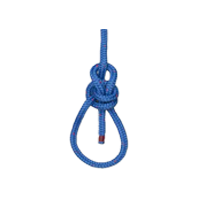Soft Shackle Tying
Measure the rope and mark it. From mark 2 pass the fid along inside the rope to exit at mark 1. Tighten the loop around a piece of rope. Pass the fid across the inner rope and pull the outer rope through. Pull your work tight and make both tail ends the same length.
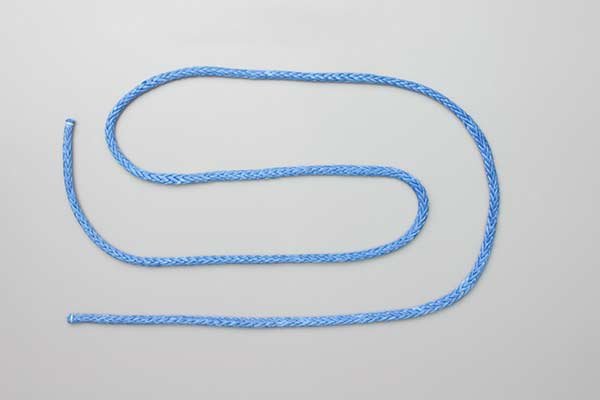
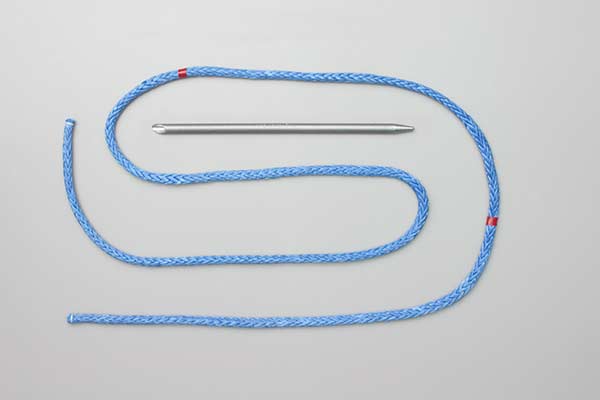
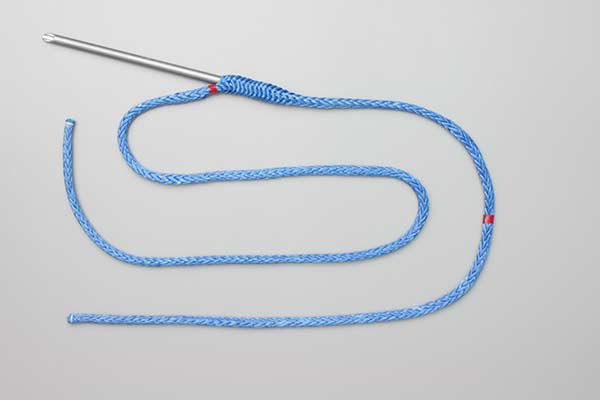
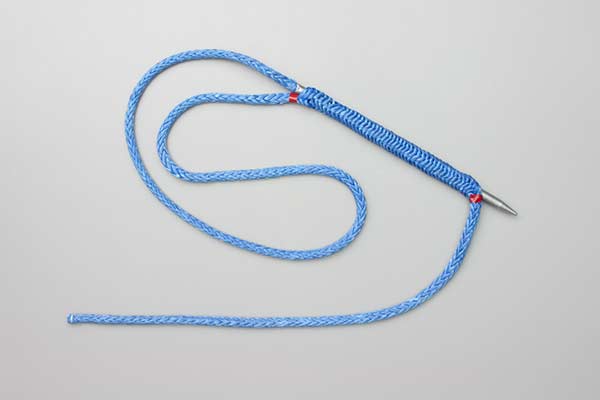



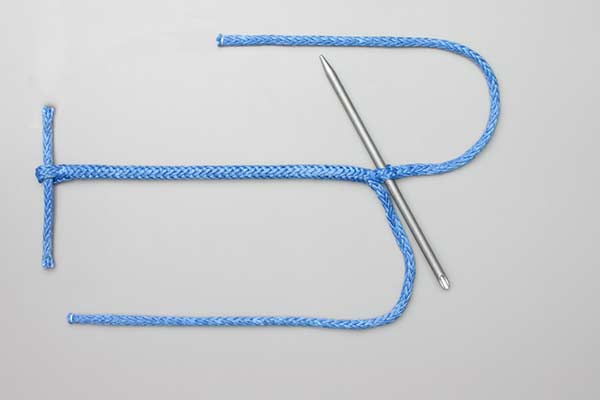
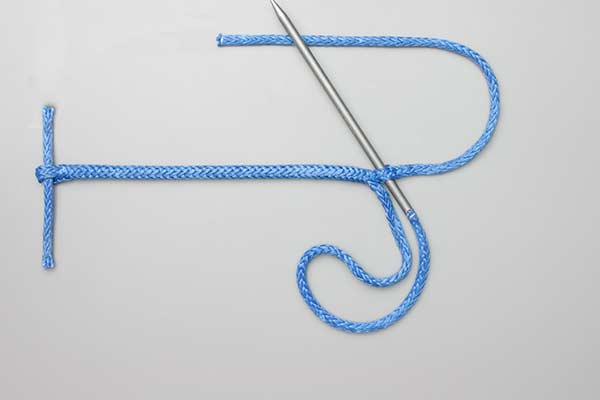
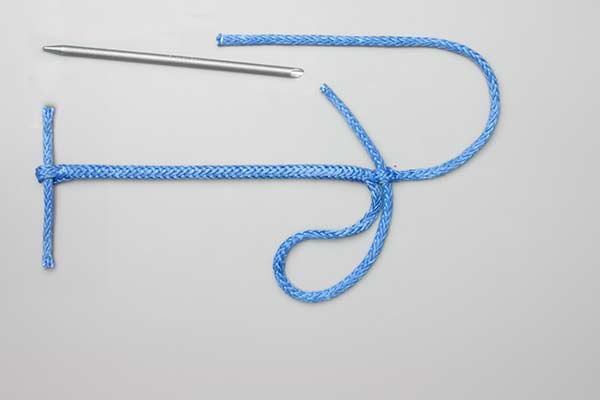




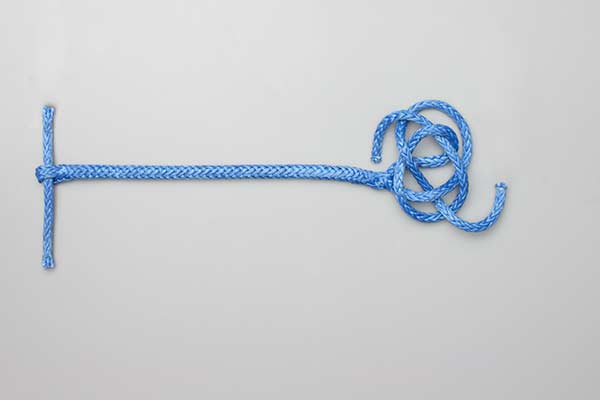
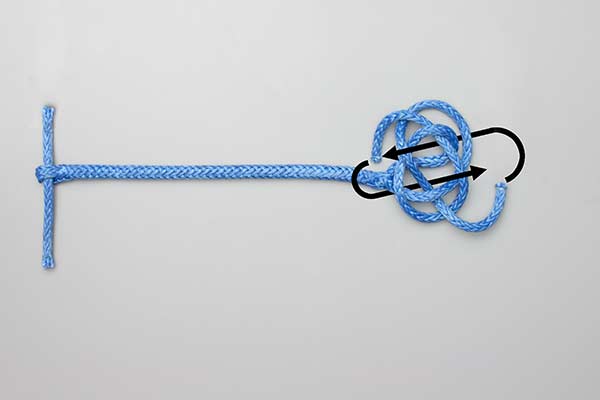

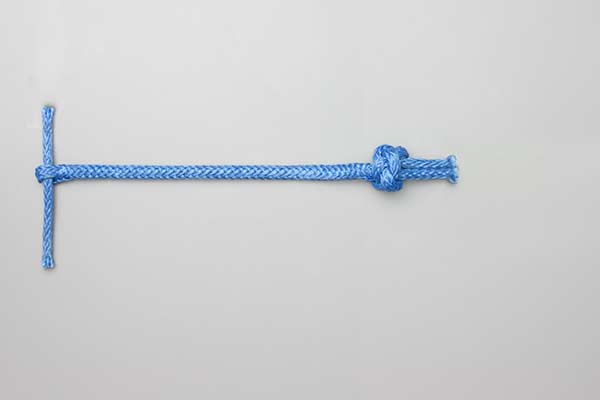

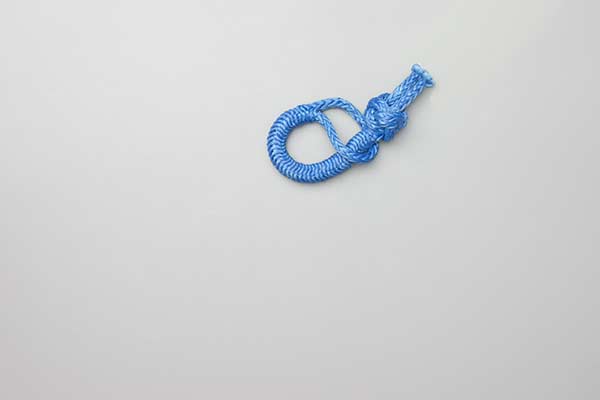

Soft Shackle Details
// Soft Shackle function Calculate(obj) // Calculate from Rope Dia and Shackle Dia { diam = parseFloat(obj.diam.value); // Rope Dia intdiam = parseFloat(obj.idia.value); // Internal Shackle diam stretch = 1.2; // Stretch Constant for 1/4" and up if (diam == .109) stretch = 1.1875; if (diam == .125) stretch = 1.23; if (diam == .15625) stretch = 1.23; if (diam == .1875) stretch = 1.21538; length1 = 10.2724*diam+3.1416*intdiam; // Shackle Length to under knot // body=(intdiam+1.5*diam)*3.1416; // Body idia2 = intdiam - 1.9099 * diam; // Usable Capacity totalrope = (111.93*diam+(1+stretch)*(intdiam+1.5*diam)*3.1416); // Total Rope Length mark1 = (53.3 * diam); // Exit Point mark2 = (stretch*3.14159*(intdiam + 1.5*diam)); // Entry Point obj.shack.value = "".concat(Math.round(10*length1)/10," in"); // Shackle Length obj.length.value="".concat(Math.round(10*totalrope)/10," in"); // Total Line Length obj.mark1.value = "".concat(Math.round(10*mark1)/10," in"); // Exit Point obj.mark2.value = "".concat(Math.round(10*mark2)/10," in"); // Entry Point obj.idia2.value = "".concat(Math.round(10*idia2)/10," in"); // Capacity } function Calculatemetric(obj) // Calculate from Rope Dia and Shackle Dia { diammetric = parseFloat(obj.diammetric.value); // Rope Dia intdiammetric = parseFloat(obj.idiametric.value); // Internal Shackle diam stretchmetric = 1.2; // Stretch Constant for 6mm and up if (diammetric == 2) stretchmetric = 1.1875; if (diammetric == 3) stretchmetric = 1.23; if (diammetric == 4) stretchmetric = 1.23; if (diammetric == 5) stretchmetric = 1.21538; length1metric = 10.2724*diammetric+3.1416*intdiammetric; // Shackle Length to under knot // bodymetric=(intdiammetric+1.5*diammetric)*3.1416; // Body idia2metric = intdiammetric - 1.9099 * diammetric; // Usable Capacity totalropemetric = (111.93*diammetric+(1+stretchmetric)*(intdiammetric+1.5*diammetric)*3.1416); // Total Rope Length mark1metric = (53.3 * diammetric); // Exit Point mark2metric = (stretchmetric*3.14159*(intdiammetric + 1.5*diammetric)); // Entry Point obj.shackmetric.value = "".concat(Math.round(length1metric)/10," cm"); // Shackle Length obj.lengthmetric.value="".concat(Math.round(totalropemetric)/10," cm"); // Total Line Length obj.mark1metric.value = "".concat(Math.round(mark1metric)/10," cm"); // Exit Point obj.mark2metric.value = "".concat(Math.round(mark2metric)/10," cm"); // Entry Point obj.idia2metric.value = "".concat(Math.round(idia2metric)/10," cm"); // Capacity } .tablecellinputleft, .tablecellinputright, .tablecellcenter { /* ## Soft Shackle Edwards */ font-size: 12px; border-style: solid; border-width: 1px; border-color: #000000; } .tablecellinputleft { /* ## Soft Shackle Edwards */ background-color: #0000FF; padding: 1px 3px 1px 3px; } .tablecellinputright { /* ## Soft Shackle Edwards */ background-color: #FF0000; padding: 1px 3px 1px 3px; } .tablecellcenter { /* ## Soft Shackle Edwards */ background-color: #EEEEEE; padding: 5px 3px 1px 3px; text-align: center; }Purpose: A rope shackle offers a strong lightweight alternative to a metal shackle. Longer versions have found various uses such as holding coils of rope.
Origin: Yachtsmen have used Soft Shackles since at least 2009. No individual appears to have claimed ownership of the concept. Anyone with more information about the history is requested to Contact me.
Alternatives: The Better Soft Shackle is made with the lines running parallel for a short way – less elegant but easier to release. The Kohlhoff Shackle has the loop composed of two lines all the way around. In the animation shown here some people incorporate a twine loop attached to the buried part to assist in releasing the shackle.
Technique: Final tightening of the Lanyard (Diamond) Knot is critical. Edwards passes the two tails through a hole in a metal bar and exerts traction using vice-grip pliers – look near the bottom of his Better Soft Shackle page. The tightened knot should feel and behave like a wooden ball. In the animation here the knot has been left loose to allow the rope to be reused.
Lengths Needed: The Edwards Calculator bases the lengths required on the shackle length. The calculator below is based on the finished inner diameter and allows input in either English or Metric units. (Note: the calculation is derived from Edwards method and the results are similar). First enter the size of the finished shackle diameter and then the rope diameter and press the adjacent Calculate button. The Fid enters the rope at Mark 2 and exits at Mark 1 (Red marks in Frame 2). The distance shown for Mark 2 is the distance beyond Mark 1. Measurements are taken from the End NOT being threaded through (bottom of Frame 2).
| English | Metric | |
| in | Inner Diameter (D) | mm |
| 7/64 in 1/8 in 5/32 in 3/16 in 1/4 in 5/16 in 3/8 in 7/16 in 1/2 in 9/16 in 5/8 in | Diameter of the Rope | 2 mm 3 mm 4 mm 5 mm 6 mm 7 mm 8 mm 9 mm 10 mm 11 mm 12 mm 14 mm 16 mm |
| Rope Length Required | ||
| Mark 1 (Fid Exit) | ||
| Mark 2 (Fid Enter) | ||
| Maximum Load Diameter | ||
| Shackle Length (L) |
To calculate these values manually, first calculate S (Stretch):
-
If D = 7/64" (or 2mm), S = 1.1875
If D = 1/8" (or 3mm), S = 1.23
If D = 5/32" (or 4mm), S = 1.23
If D = 3/16" (or 5mm), S = 1.21538
Otherwise S = 1.2
Where
-
R = Rope diameter, e.g., 0.25",
D = Intended Diameter of Shackle, e.g., 2":
Then:
-
Rope Length required =111.93 x R + (1 + S) x (D + 1.5 x R) x 3.1416
Mark 1 = 53.3 x R
Mark 2 = S x 3.1416 x (D + 1.5 x R)
Maximum Load Diameter = D - 1.9099 x R
Shackle Length = 10.2724 x R + 3.1416 x D
Tail Lengths: If the knot has been forcefully tightened, trim the tails to about 1/4" long. If not really tight leave at least an inch as shown in the animation.
Use: The completed shackle provides an excellent way of attaching two jib sheets to the jib – see photo on left courtesy of Allen Edwards. Here Edwards uses a Velcro Strap to keep the Lanyard Knot centered in the ring and out of the way of the rigging.
Advantages: The soft shackle weighs little and is less likely to cause injury it strikes a crew member. The array of soft shackle and jib sheets pulls across in front of a mast with little tendency to catch - reducing the need to place a crew member up on the foredeck.
Strength: Soft shackles have been extensively tested. The ideal strength might approach four times the line strength as there are two lines on each side of the shackle – four in all. In practice, the line just under the knot and the kinking in the loop are the weak points and Evans Starzinger has shown that breakage typically occurs around 175% of Line Strength. This means when attached to a jib sheet using similar rope, the sheet will part first – not the soft shackle.



